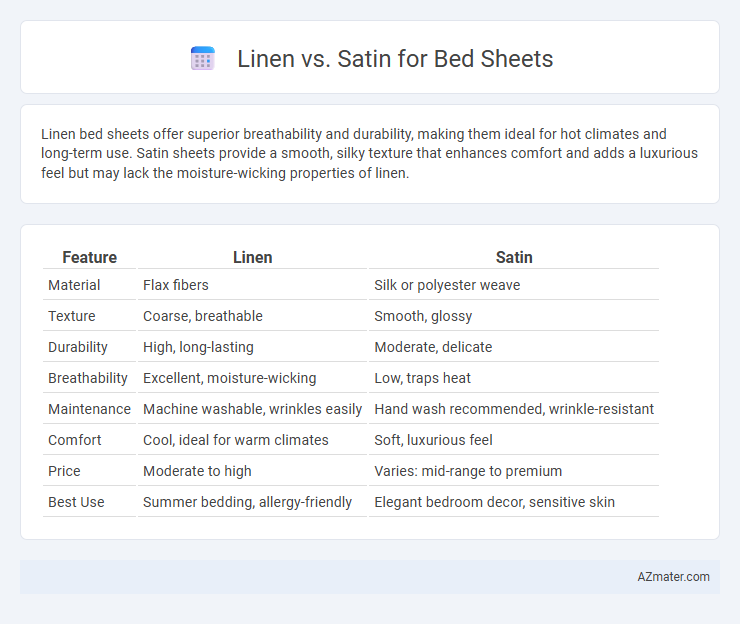Linen bed sheets offer superior breathability and durability, making them ideal for hot climates and long-term use. Satin sheets provide a smooth, silky texture that enhances comfort and adds a luxurious feel but may lack the moisture-wicking properties of linen.
Table of Comparison
| Feature | Linen | Satin |
|---|---|---|
| Material | Flax fibers | Silk or polyester weave |
| Texture | Coarse, breathable | Smooth, glossy |
| Durability | High, long-lasting | Moderate, delicate |
| Breathability | Excellent, moisture-wicking | Low, traps heat |
| Maintenance | Machine washable, wrinkles easily | Hand wash recommended, wrinkle-resistant |
| Comfort | Cool, ideal for warm climates | Soft, luxurious feel |
| Price | Moderate to high | Varies: mid-range to premium |
| Best Use | Summer bedding, allergy-friendly | Elegant bedroom decor, sensitive skin |
Introduction to Linen and Satin Bed Sheets
Linen bed sheets, crafted from natural flax fibers, offer exceptional breathability and moisture-wicking properties, making them ideal for hot climates and sensitive skin. Satin bed sheets, typically made from silk or polyester, are known for their smooth, glossy surface that provides a luxurious feel and reduces friction on hair and skin. Both fabrics differ significantly in texture, durability, and maintenance, influencing sleep quality and overall comfort.
Key Differences Between Linen and Satin
Linen bed sheets are made from natural flax fibers, offering breathability and durability, while satin sheets are typically woven from silk or synthetic fibers, providing a smooth, glossy finish. Linen excels in moisture-wicking and temperature regulation, making it ideal for hot climates, whereas satin is valued for its luxurious feel and elegant appearance but may trap heat. Maintenance-wise, linen requires less delicate care and softens over time, while satin demands gentle washing to preserve its sheen and texture.
Comfort and Breathability Comparison
Linen bed sheets offer superior breathability and moisture-wicking properties, making them ideal for warm climates and hot sleepers who value temperature regulation and natural fibers. Satin sheets, often made from polyester or silk, provide a smooth and luxurious feel but tend to trap heat and lack the airflow that enhances comfort during sleep. Choosing between linen and satin depends on prioritizing breathability and temperature control versus a silky texture and aesthetic appeal.
Temperature Regulation: Linen vs Satin
Linen bed sheets excel in temperature regulation due to their natural breathability and moisture-wicking properties, making them ideal for hot sleepers or warm climates. Satin sheets, often made from synthetic fibers like polyester, tend to retain heat and provide a cooler, smoother surface but may trap warmth, causing discomfort in high temperatures. Choosing linen enhances airflow and keeps the body cool, while satin offers a silky feel but less effective temperature control.
Durability and Longevity
Linen bed sheets are known for their exceptional durability, with fibers that strengthen over time and resist wear and tear better than satin. Satin sheets, often made from polyester or silk, tend to be less durable due to their delicate weave and are more prone to snagging and pilling. For long-term use, linen offers greater longevity, maintaining its texture and strength even after repeated washing.
Maintenance and Care Requirements
Linen bed sheets require gentle washing with mild detergent and benefit from air drying to maintain their breathability and natural texture, while frequent ironing can preserve their crisp appearance. Satin bed sheets demand delicate handling with cold water washes and low-heat drying to prevent fabric damage and maintain their smooth, glossy finish. Both fabrics should be stored in a cool, dry place to avoid mildew and extend their lifespan.
Allergy and Skin Sensitivity Considerations
Linen bed sheets offer natural hypoallergenic properties and breathability, making them ideal for sensitive or allergy-prone skin by reducing dust mite accumulation and moisture buildup. Satin, often made from synthetic fibers like polyester, may trap heat and allergens, potentially irritating sensitive skin and exacerbating allergic reactions. Choosing linen over satin can promote better airflow and skin comfort, minimizing irritation for individuals with skin sensitivities or allergies.
Aesthetics: Texture and Appearance
Linen bed sheets offer a natural, textured appearance with a matte finish that softens over time, enhancing a relaxed and rustic aesthetic ideal for minimalist or bohemian decor. Satin sheets provide a smooth, glossy surface that reflects light, creating a luxurious and elegant look favored in contemporary or glamorous bedroom styles. The choice between linen's breathable, tactile appeal and satin's sleek, shiny finish significantly influences the overall visual and tactile experience of bedding.
Price and Value for Money
Linen bed sheets typically command a higher price due to their durability, breathability, and natural fiber benefits, making them a long-term investment with excellent value for money. Satin sheets, often more affordable and made from synthetic fibers, offer a smooth, luxurious feel but may lack the longevity and moisture-wicking properties of linen. Choosing between linen and satin largely depends on budget constraints and the desired balance between immediate cost and lasting comfort.
Which is Better: Linen or Satin for Bed Sheets?
Linen bed sheets offer superior breathability, moisture-wicking properties, and durability, making them ideal for hot sleepers and those seeking natural, eco-friendly fabrics. Satin bed sheets provide a smooth, silky texture that reduces friction on skin and hair, enhancing comfort and reducing wrinkles but may trap heat and require more care. Choosing between linen and satin depends on personal preference for temperature regulation versus softness and aesthetic appeal.

Infographic: Linen vs Satin for Bed Sheet
 azmater.com
azmater.com